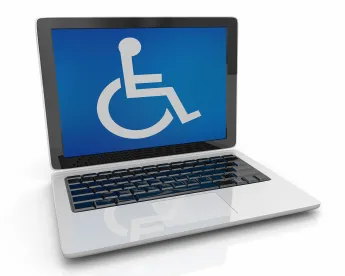What user experience does a visually impaired person have when visiting your website? Is your website designed with barriers for people with disabilities? These are among the important questions to ask to ensure that all visitors can perceive, understand, navigate, and interact with you on the Web.
Slow to adopt businesses and other institutions were inundated last year with legal challenges to the accessibility of their websites and mobile apps, as the number of lawsuits filed alleging violations of Title III of the Americans with Disabilities Act (“ADA”) and related state laws appeared to reach a record high. With no slowdown in sight in our increasingly digital world, organizations should take proactive steps now to ensure their websites and mobile apps are accessible to people with disabilities.
Title III of the ADA prohibits discrimination on the basis of disability in places of public accommodation, including businesses, hotels, hospitals, and private institutions of higher education. Institutions of higher education are bound by the ADA (Title III applies to private institutions and Title II applies to public institutions) and Section 504 of the Rehabilitation Act of 1973, which also prohibits discrimination on the basis of disability in an institution’s educational programs or benefits. While the ADA’s definition of “public accommodation” lists only physical places, like restaurants and retail stores, many courts, including those federal courts in the First and Seventh Circuits, have held that websites qualify as public accommodations. In April 2021, the U.S. Court of Appeals for the Eleventh Circuit joined the Third and Sixth Circuits in holding that places of public accommodation are limited to physical places. However, organizations whose websites reach a national audience may be subject to litigation in federal jurisdictions more favorable to would-be web accessibility plaintiffs and in states with anti-discrimination laws that cover digital accessibility claims.
The DOJ under President Joe Biden has also made web accessibility an enforcement priority. In late 2021, the DOJ settled enforcement actions with Rite Aid Corporation and Hy-Vee Supermarket Chain regarding the accessibility of their online COVID-19 vaccine registration portals and with the Champaign-Urbana Mass Transit District regarding the accessibility of its public transportation website and mobile apps. Under all three settlements, the companies agreed to quickly make their content conform to the Web Content Accessibility Guidelines (WCAG), Version 2.1, Level AA.
Organizations should not wait until they receive a demand letter or are served with a complaint to recognize the importance of digital accessibility. Rather, they should proactively seek to make and maintain their websites in conformance with WCAG Guidelines, which are considered the gold standard in the absence of legislative or regulatory web accessibility requirements. While no compliance effort can prevent all legal challenges, taking proactive steps towards accessibility can discourage serial filers and enhance responses to demand letters and defensive strategies if a lawsuit is filed.
Plaintiffs’ firms often use automated evaluation tools to identify potential defendants. Organizations should likewise audit their own websites and mobile apps as a first step to identify issues for remediation. Many vendors and consultants offer services to perform audits and assist in remediating websites and apps to make them and maintain them as accessible. But beware: not all accessibility vendors are created equal. Vendors offering to make websites accessible through cost-effective “overlays,” or automated software that claims to detect and fix accessibility issues, have been subject to recent criticism, including in litigation. Organizations looking to make their websites accessible should exercise care in selecting outside vendors that will add value rather than widen the target.




 />i
/>i
